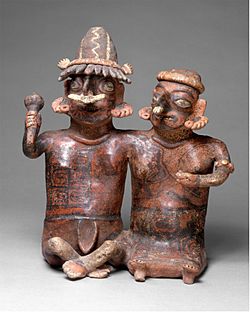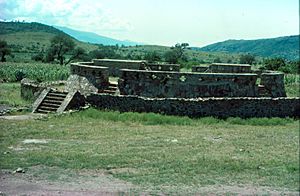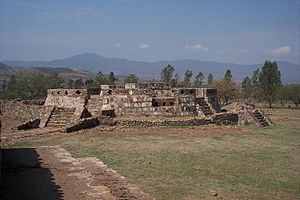Ixtlán del Rio (archaeological site) facts for kids
Quick facts for kids Shaft Tomb Tradition Culture – Archaeological Site |
||
| Name: | Ixtlán del Río Archaeological Site | |
| Type | Mesoamerican archaeology | |
| Location | Ixtlán del Rio, Nayarit |
|
| Region | Mesoamerica | |
| Coordinates | 21°02′23″N 104°20′41″W / 21.03972°N 104.34472°W | |
| Culture | Aztatlán Tradition - Nahua | |
| Language | Nahuatl | |
| Chronology | 300 BCE to 1521 CE | |
| Period | Mesoamerican Preclassical, Classical, Postclassical | |
| Apogee | 750 – 1100 CE | |
| INAH Web Page | Ixtlán del Río Archaeological site | |
Ixtlán del Rio is an archaeological site located in the Ixtlán del Rio municipality, on the south west region of the Nayarit State, Mexico. It is also known as "Los Toriles" and contains the only vestiges of the western cultures in Nayarit.
The presence of prehispanic vestiges in the form of petroglyphs are registered in five areas, the most important are "El Terrero", "Sayulapa" and "El Veladero", which depict sgraffiti lines and representations of abstract figures, such as spirals with rays.
Of the traditional Shaft Tombs, five large concentration areas are identified, containing human bone remains; domestic pottery ollas, comales and cantaros (pitchers)]; as well as sculpture type remains (human and animal figures).
Contents
Toponymy
The word "Ixtlán" is of Nahuatl origin, composed by the words "Itz-ittztell" that means obsidian, and "Tlán", that means place with abundance, that is, "Place where obsidian is abundant".
According to the Mexican Municipalities Encyclopedia, Ixtlán, means place dedicated to Ehécatl, Wind God .
History
This important site was very possibly occupied from 300 BCE through 600 CE. During the first stage a cultural complex was developed known as the Shaft Tomb tradition in which offerings were placed inside of funeral chambers. Between 500 and 600 CE the Shaft Tomb tradition is abandoned and its development is registered within an ample cultural region known as Aztatlán, with an apogee towards 750 and 1,100 CE.
With the "Tradición Aztatlán" develops a new way of life and it begins towards 750 – 900 CE. This cultural development is identified as mid-Ixtlán period (750 - 1110) that represents the apogee of the city, dedicated to Ehécatl (Wind God); and late Ixtlán (1110–1525CE) identified by red smooth ceramic for domestic use as well as cajetes and tripod molcajetes decorated with white designs over red.
The city was founded in the 12th century, by Nahuatlaca tribes en route towards the Valley of Mexico, forming the Ahuacatlán Lordship, known by its building construction and trading of obsidian goods.
It is then that the urban settlement grows considerable with the construction of large terraces, palaces, temples and altars, acquiring a certain regional importance as manufacturing and commercial trade center. Although more than 85 mounds and structures have been located in the site, that remain still unexplored, at the moment it is only possible to visit fifteen structures, among them the building called Quetzalcoatl Temple that displays a circular shape with a parapet surrounding it and with peculiar perforations in cross shape.
The temple has two altars on top of the Mexico Central Plateau style. Other important buildings are structures called "Reliefs Palace", "Columns Palace", the "Four Column Palace" complex and the "Square Palace".
Ixtlán is the most studied archaeological zone in Nayarit. Its influence zone extended to the present day municipalities of Ixtlán del Rio, Ahuacatlán, Jala and Santa Maria del Oro. Their main towns were Cacalután, Tepuzhuacán, Mexpan, Zoatlán, Xala, Jomulco, Tequepexpan, Camotlán, Tetitlán, Acuitapilco and Zapotán.
Petroglyphs
In Santiago Ixcuintla, INAH has registered the existence of petroglyphs from the "Los Concheros" epoch, in the Las Parejas, Emérita, Yago, El Caballo and Acatán de las Piñas sites, with a total of 13 engravings, including the "Piedra Galana".
The presence of prehispanic vestiges in the form of Petroglyphs are registered in five areas, the most important are "El Terrero", "Sayulapa" and "El Veladero", which depict sgraffiti lines and representations of abstract figures, such as spirals with rays.
Ceramic

This stage of prehispanic development distinguishes and identifies western Mexico from other mesoamerican cultural expressions, during the late formative period and early classical. The Nayarit shaft tomb complexes are identified within the early Ixtlán period (300 BCE to 300 CE), and three distinctive clay modeling styles have been defined: Chimisco, Ixtlán and San Sebastian.
The pottery of this tradition shows abundance of colors, predominating red, orange, yellow beige and the "negative" form. Common themes are human beings as warriors, musicians, women, sick people and couples.
Structures
Ixtlán del Río archaeological site has a plaza, with an altar with four small stairways and to the sides buildings that appear to be small rectangular rooms.
These temples/rooms are built on platforms with adobe pilasters, as well as sidewalks and stairways.
One of these temples has a road paved with stone slabs, which leads to the round monument, discovered in 1948 by Prof. José Corona Núñez and eloquently describes his discovery, stating: "the round monument has 30 meters in diameter by 4 meters high;" sloped walls crowned by a perforated parapet with crosses, as if skylights, four access stairs, limited by alfardas die finished, some of them still have cross shaped handrails.
Above, within the round patio, limiting the parapets are pyramid bases, one to the north and another at the south, with stairs geared toward the center. The North has a smooth vertical panel and the south has a beveled cornice. According to the remains found, these bases maintained small altars with column portals, ceilings and stone altered battlements: one shaped as arrowheads, others composed of a disk with two circles engraved, this monument is called "Quetzalcoatl Temple" and is believed to belong to the Toltec horizon by the Toltec cultural traits observed in its architecture.
In earlier times, between 300 BCE and 600 CE., flourished a cultural complex known as shaft tombs tradition characterized by underground architecture and offerings deposited inside the funeral chambers. Its origins are ancient and have been found in the neighboring States of Colima, Zacatecas, Jalisco and Michoacán.
Around 500 to 600 CE.,the shaft tomb traditoion disappears and a new way of perceiving life starts from 750 to 900 CE. This cultural development is identified as the Aztatlán tradition and is known in the mid-Ixtlán period (750 to 1110) which represents the apogee of this city dedicated to the God of the wind; and late Ixtlán (1110 to 1525) identified by red smooth ceramics household items and cajetes and tripod molcajetes with white decor on Red.



